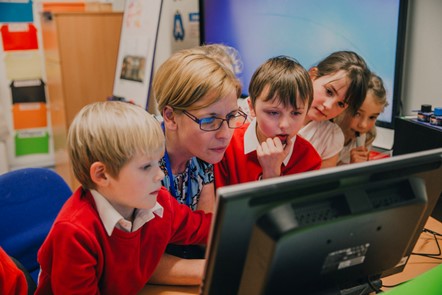There are many challenges and benefits to scaffolding in primary education. It can be time-consuming, there may even be inappropriate modelling and also lack of personnel. However, scaffolding learning still remains beneficial in the 21st century classroom especially when it comes to developing student ICT capability in primary education with ICT.
So what is educational scaffolding? It is to do with how you adjust the route of learning for an individual student. You aim when scaffolding learning is to help that child to be able to solve a problem, carry out a task, or achieve a goal.
When ICT is involved, the level of complexity can be different if not challenging at times. The same principles still apply and in the following sections, I will explain how this can be achieved when integrating ICT in meaningful context-driven activities and in such a way that it will develop student ICT capability.
I will also explain how scaffolding in primary education can be achieved through the affordances of the learning environment in relation to the development of ICT capability.
Affordances take into account the whole learning environment. It includes you as the teacher, the other resources, the other students, the cultural context, student prior knowledge, the opportunities offered by the technology, and the structural and constraining features of the problem to solve.
When scaffolding in primary education in relation to ICT integration, it is important then that you understand the role of ICT in the activity and you set clear goals for its use.
Additionally, you need to remember that the teacher as a scaffolder in primary education has an impact on student ICT learning. Scaffolded learning is directed linked to the level of ICT capability that you have as a teacher. The higher the level of ICT capability you may have the more natural it will be for you to scaffold instruction for children that will develop their ICT capability.
This is why when you plan to use ICT in the lesson activities that you take into account the children’s ICT capabilities. Not all will have sufficient skills. You will need to identify what they should be expecting in terms of routines, ICT techniques, concepts, processes, and higher order thinking skills.
The development of ICT capability is super important in primary education as there are four levels of progression in the ICT Capability Learning Continuum placed within the charge of teachers. Here are my tips when scaffolding in teaching ICT capability today.

4 Ways to Scaffold Learning in ICT Capability
Adult support
Sometimes you may be lucky to have additional adult support when teaching ICT-based activities. When you do, you need to consider how to best use this support.
It is a good idea to brief the adult helper on the technical aspects of the hardware or software to be used. Then, if you know the level of ICT capability of the children well enough, you should be able to determine who will need additional challenges. It will also involve the teacher as a scaffolder differentiating your support according to grouping the children.
Using your record to plan, target and focus
After you have applied formative assessment strategies to determine the level of capabilities in ICT, it is important that you use these records to re-focus your teaching in the subsequent activities. For example, if you find that you have overestimated the capabilities of the children, in their next project or activity you can scaffold learning more carefully to provide more opportunities to build the children’s skills and develop their routines and ICT techniques.
Leave a gap for learning to occur
The Zone of Proximal Development suggests that there must be a gap to bridge between the child’s abilities and the requirements of the problem situation if learning is to occur. You must reduce the gap by adding affordances of the environment where learning occurs such as:
- Providing information sheet to assist in the use of the software.
- Demonstrating clearly on a big screen of the actions to be followed.
- Asking a series of structured leading questions.
- Organising a class discussion of results.
If you leave little or no gap, then only learning in the subject will occur and therefore, insufficient development of ICT capability will result. A manageable gap between affordances and abilities in areas of ICT techniques and processes is needed.
Additionally, to encourage the development of higher order thinking skills, the affordances for planning, monitoring and evaluating activities must not be too great.
Adjust your support for each component of ICT capability
ICT capability comprises of 5 components. For each is the recommended scaffolding of learning:
Routines – if students do not meet these important ICT techniques sufficiently frequently, provide them with focused practice tasks for homework.
ICT techniques – help students associate the actions involved with an ICT technique to the effect it achieves. It is important that you provide the minimum amount of support. They can often remember ICT techniques or work things out themselves with little prompting concerning where to look for options. Withdraw this support as soon as possible.
Processes – this is where the teacher as a scaffolder really counts. The minimum amount of support should be given and you should scaffold learning by asking questions, prompting and demonstrating when needed, and then withdraw as much support as possible to see what they can do unaided.
Higher order thinking skills – at this stage, you determine the support needed after the scaffold has been withdrawn. Support can be given by modelling strategic planning by thinking out aloud to show them the questions you might ask.
Concepts – challenge naïve ideas about using ICT techniques and software both in whole class teaching and individually or in groups. For example, if a student uses spaces to spread out text on a line or page, you can show them the effect of adding extra text so that the spaces move to a different position in the line etc.
The role of the teacher as a scaffolder will always remain vital even if technology continues to provide scaffold in some way for students. In this context, your role as a teacher becomes more important and not less. Your ability to manipulate the affordances of the environment will always remain central to your role in teaching ICT capability in meaningful context-driven activities

The Importance of Scaffolding in the Classroom
Just as builders use scaffolding for support to achieve their goals, so too does the teacher as a scaffolder in the classroom. The teacher as a scaffolder ensures that there is an instructional safety net for students that will enable them to become problem solvers.
The need for instructional scaffolding is important if the students are to develop skills that will help them lead to their own learning. As a teacher, you will also need to differentiate assignments and activities.


Scaffolding Strategies to use with your Students
Scaffolding a lesson is about dividing the learning into separate pieces and providing a tool to overcome each piece. That is, what is usually done first with children. For students who have some kind of learning difficulty, they may have to make differentiations to modify the task or make the corresponding adaptations.
To do all this, the teacher is a fundamental part, they know the students and their learning problems, so the teacher as a scaffolder is a good option. The teacher should be the tool that leads the student to learn the content, that is, not just a content provider.
Scaffolding strategies.
The teacher as a scaffolder must have some strategies so that regardless of the course you are studying in the best possible way, the students are the following:
- Show and say: an important part of the scaffolding is in what we see, that is, inexperience. Every opportunity we have to teach or show students is what they expect us to do. You can try an activity, it is about dividing the class into two groups, the first one is in the centre surrounded by the second group. The group that is in the centre is going to carry out a specific activity, so it will be taught to the group that surrounds it. It is important that as a teacher we show students the result before doing this activity. To do this, you can guide students through a step-by-step process indicated as a model of the finished product.
It is important to keep in mind that the skills that children have been developing, this means that each thought they release is very important.
- Previous knowledge: you can propose to the students that they tell their experiences or the ideas that you have on any subject of study, this is done so that they can relate it to their lives. They can even offer suggestions, leading us to find different connections and understand the content.
It is important that learning in the classroom can be started through some price knowledge that the students have, so we can use it as a basis for future lessons. It is a scaffolding technique.
- Have time to talk: Students will need some time to make ideas clear. Also to understand learning. So if a more or less structured discussion is held, it will be very important for the children and their level of maturity.
- Pre-teaching vocabulary: You can also call it front-loading vocabulary. It is an important strategy and that teachers do not usually use normally. We may be guilty that the students do not have a concrete basis so that the activity is not so complicated. They are usually prepared and this may be one of the options for which students lose interest, misbehave or even fall asleep.
The previous vocabulary means that teachers can present different words to their students through photos and in a specific context.
- Use visual strategies: we can work with images, charts or graphs as scaffolding tools. These organizers will help us to represent the most important ideas in a very visual way, along with the organization and understanding of the concepts so that the students do not have problems.
- Pauses, questions, and reviews: it is a very good way to see whether or not you have fully understood each concept. This strategy works like this, you must first share an idea, then pause, ask a strategic question, and pause again to answer what we have understood.
Conclusion.
In conclusion, scaffolding strategies are a good way for our students to have a better understanding of the concepts and content we are working on. For this, the teacher plays a very important role. This is because the teacher as a scaffolder has to use these strategies so that their students learn the information in the best possible way.
The teacher must give him the necessary means to be able to meet the proposed challenge, for this reason, it is so important that the teacher is that mediator.